Because of blackjack’s popularity, many people had the chance to witness someone playing the game at least once in a movie or somewhere else. As shown on television, for example, it does not look like a big deal, just a card game with some basic rules. This is the reason why so many players possess delusional confidence and knowledge and often lose a considerable amount of money when they go to a casino.
Moreover, professional gamblers always manage to spot who the novices in the casino are before they have even started the game properly as their choices and behaviour say it all. It is worth mentioning that in order to become winners, they need to be well-prepared and know the rules by heart.
Blackjack Basic Rules
As already mentioned, the basic rules of the game are not so hard to be understood and this is the reason why so many people believe that they have a good chance of winning. In order to do so, players need to reach a final score of twenty one without surpassing it.
They compete against the house and this is the reason why their hand’s total should be higher than the dealer’s. The player can also win if the dealer’s hand total exceeds 21 or if they get a blackjack against any other hand of the dealer.
If the dealer’s hand is closer to twenty one or the players go over this number, the result is ‘busting’ or losing the round in other words. However, a lot of casinos offer many additional options in order to continue the game and make it more exciting and enticing for them.
For instance, when players manage to make a blackjack, they receive a bonus payout which can vary depending on the casino. The majority of gambling venues offer bonus payouts of 3 to 2 for blackjacks, which corresponds to one-and-a-half times the original bet of the player. Blackjack is when players have two cards in their hand – an ace and one that gives them ten points.
Card Values
At this point what usually comes to mind is the question how the cards are valued. There is nothing complicated about the card system and it can be defined as rather simplified. The ace is the most powerful card in the deck as it can be counted as one or eleven and it is entirely up to the players’ prudence to decide. A queen, king and jack are worth ten points and the rest of the cards are counted with the numeric value written on them.
In this sense, when players happen to have a face card and an ace in their hand, they should count it as eleven so that they reach exactly twenty one which is Blackjack. Usually, they are paid even money for their bet, except for the cases when they have Blackjack as the payout for it is 3/2. It is worth mentioning that the payout can vary, depending on the casino and the variation of the game which is the reason why it is always best to double check it in advance. It is printed in large font on the table’s felt.
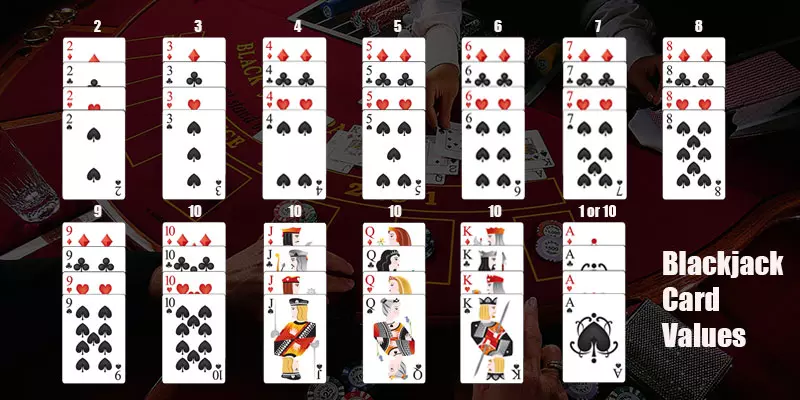
The Difference between Soft and Hard Hands
To arrive at their hand total, the player must merely add up the values of their cards. Suppose for a moment you receive a K-5-6. Congratulations! You have a total of 21 that wins on all occasions except for the instances when the dealer has a blackjack or pushes by drawing to 21 themselves.
In this vein, a push is a tie in blackjack, in which case no one wins or loses. The player receives their whole wager back. They can let it ride, take it off or resize it for the next round. When it comes to types of hands, there are two of those in blackjack. A hard hand is one that either lacks any aces or has them but they are counted as 1.
Hard hands 12 through hard 17 are particularly detrimental for players because they stand bigger chances of losing than winning against the dealer. Soft hands contain aces that can be given the value of 1 or 11. These are great both for the player and the dealer because they cannot bust after they take one more card.
A hand remains soft until you draw a card that would cause you to go over 21 if the ace is counted as 11. Instead, the ace is automatically counted as 1 to prevent this from happening and the hand transitions from soft to hard.
American vs. European Style of Card Dealing in Blackjack
There are two distinct styles of card dealing when it comes to blackjack, depending on where you play. It is essential to specify that most online and landbased casinos in the United States do not refer to their tables as “American Blackjack”. The US varieties of the game use different names, such as Vegas Strip Blackjack, Vegas Downtown Blackjack, and Atlantic City Blackjack.
One key difference between American and European varieties of the game is how the dealer’s cards are dealt. Casinos across the USA largely offer hole-card games where the dealer receives two cards during the initial deal. One card is exposed while the other one is dealt face-down. The latter is the dealer’s hole card. When hole cards are in play, the dealer would check the face-down card when their exposed card is an ace, 10, King, Queen, or Jack.
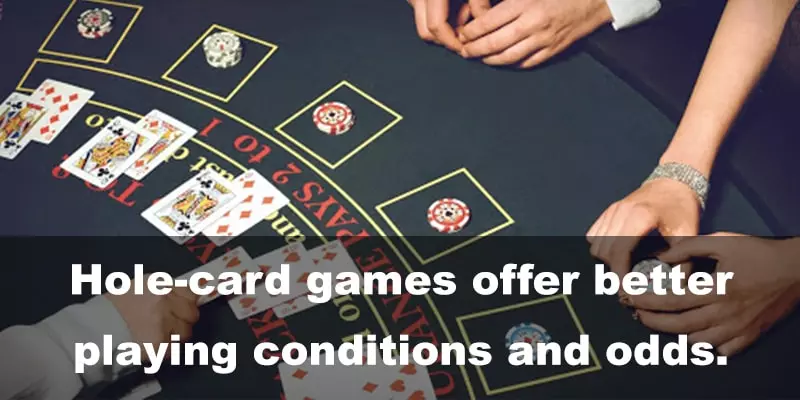
This procedure is called “peeking” for a blackjack. If the dealer has a blackjack, they turn their hole card over and all players lose unless they also have blackjacks. Generally speaking, hole-card games offer better playing conditions and odds.
The second style of card dealing prevails in European and Australian casinos. When a round of play starts, the dealer gets only one exposed card and receives their second card only after the players have completed their hands. This might seem like a negligible difference but it further tilts the odds in favour of the casino.
Number of Players and Card Dealing
The number of players a blackjack table can accommodate depends on where you play. Most landbased casinos offer blackjack tables that can accommodate up to seven players although one can also come across tables that allow five or even twelve patrons to simultaneously join the game. Most multi-hand online variations enable you to play on a maximum of five betting positions (betting spots).
Brick-and-mortar gaming houses would also allow up to three patrons to post chips in a single betting box, especially at full tables. This practice is called “betting behind” but we shall tackle it later on in this blackjack guide.
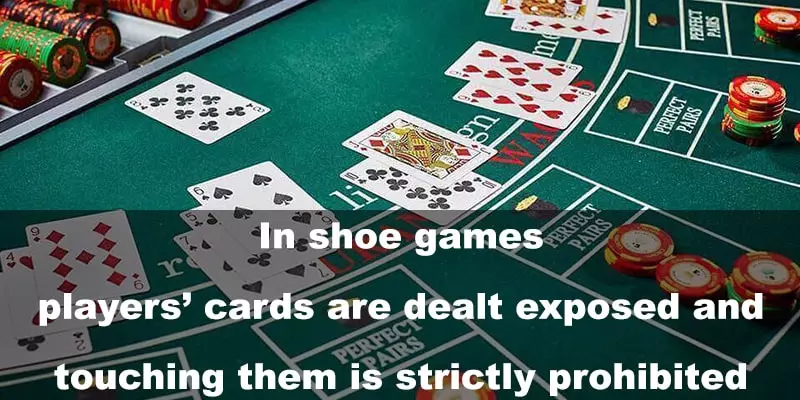
For the time being, it suffices to mention that the term refers to when one posts a wager on the hand of another seated player. This option is also available online at live-dealer blackjack tables. The difference is that usually an unlimited number of patrons can bet behind the same seated player.
Another thing that bears consideration, at least when one plays at a landbased venue, has to do with the number of decks. If a blackjack game is dealt out of one or two decks, the players receive their cards face-down and can touch them to check their values, without removing them from the table. The dealer holds the deck or decks in their hand in this case.
Games where four to eight decks are utilized are dealt out of a shoe, with the dealer taking the cards out one at a time. The players’ cards are dealt exposed and touching them is strictly prohibited. So is touching your chips once you have placed a wager in your betting spot. All of these rules are important for preserving the game’s integrity and preventing cardsharps from cheating.
Buying In and Playing Order
To join the game, the player must first purchase some chips from the dealer at the table. The banknotes should be placed on the felt and not handed directly to the dealer. The house representative is strictly prohibited from taking money directly from the players’ hands.
The dealer would spread the banknotes on the table so that surveillance can clearly see how much the player buys in for. The pit boss, i.e. a casino employee placed in charge of the blackjack tables, would confirm the transaction as well.
The dealer would then give the player the corresponding amount in chips. The player is now ready to make their first bet. The chips are placed within the betting box without touching its borders. Players must remember they cannot resize their wagers or even touch their chips once the dealing of the cards has started.
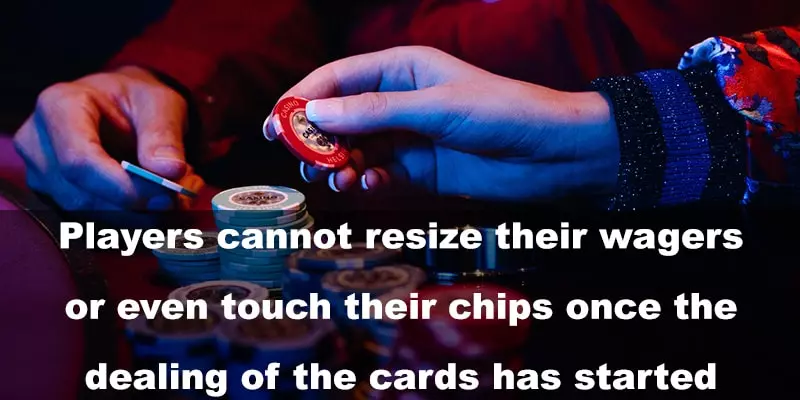
The minimum and maximum bet limits are displayed on a tiny plaque at the side of the table. These will be different depending on regulations as well as on where you play. The dealing of the cards then starts from the dealer’s left and continues clockwise.
The dealer gives one exposed card to each seated patron and then one hidden card to themselves. They make a second pass around the table, repeating this procedure, only this time they will receive their second card with its face upwards.
Now everyone at the table has two cards and can make their playing decisions. Decision-making starts from the player seated to the dealer’s left and continues clockwise, in the same order as that of the card dealing.
Each player must add up the values of their first two cards to determine the strength of their hand and decide how to play it out. The dealer is the last person to play their hand. They reveal their hole card and complete their hand based on fixed rules, outlined by the house.
No Decision-Making for the Blackjack Dealer
Dealing blackjack can be a tedious job since no decision-making is involved in the process. Instead, blackjack dealers follow house rules when playing out their hand. There are two common variations of the dealer’s standing rules, the first one being “The dealer must draw to 16 and stand on all 17s”. Once the dealer reaches or exceeds 17, they must stand pat and cannot draw any more cards to their hand.
The second rule requires the dealer to draw to 16 and hit soft 17. This rule slightly tilts the winning odds in favour of the house. Contrary to popular belief, a total of 17 is not considered strong enough in blackjack. Therefore, a dealer hitting soft 17 gets the opportunity to increase their hand’s value and outdraw the players.
Glossary of Blackjack Moves
Apart from the rules of the game itself, there are also some behavioural ones which indicate how players should act during the game. For instance, it is not recommended to talk on the table and in order to indicate their next move, they need to use particular gestures. Before explaining them thoroughly, however, there are some terms used in the game which every gambler should get familiar with.
In Blackjack, players ‘hit’ when they would like to take an extra card and ‘stand’ when they would like to end their turn. ‘Split’ is when two of the cards have an equal value and therefore, they are separated to create two independent hands.
The player must make a second wager to the amount of the original bet before they can split a pair. The dealer automatically draws one card to each split to complete it. The two hands are played one after the other.
‘Doubling’, as the name also hints, is a move where the player places a double wager, gets another card, and finishes their turn. This move is recommended in certain situations only and against specific cards of the dealer. The same goes for splitting.
Players, who realise during the game at some point that they are bound to lose, can ‘surrender’ which means that they give up half of their bet to fold their bad hands. It is worth noting that some casinos do not allow this move as it can be very beneficial in particular situations.
If available at all, the late surrender rule is more common. This is when the player can fold a hand only after the dealer has determined whether they have a blackjack when their exposed card is an ace or a ten.
By contrast, early surrender is when the player can withdraw from the round before the dealer checks their exposed card for a blackjack. Early surrender has been driven to extinction by the massive edge it gives to players. The rule is still available online in a select few blackjack variations.
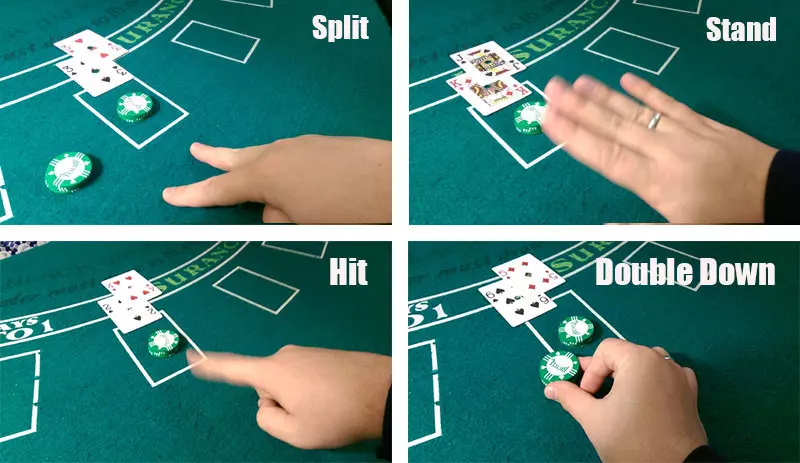
Hand Signals for Blackjack Playing Decisions
As this is only the theoretical side of the game’s rules, our next step is to clarify how they are actually applied in the game. In order to hit, players need to tap the table using their fingers and in order to stand – wave their hand over the cards.
They can split by putting more chips next to their initial bet and spreading their index and middle finger in a V shape. To double down, players must again post extra chips up to the size of their first wager. The chips are placed next to those for the initial bet but never on top.
As for surrendering, the player must draw an imaginary vertical line behind their betting spot, using their index finger. It is worthwhile noting that tenderfoot dealers would sometimes mistake the hand signal for surrendering with that for hitting. To avoid such mistakes, players are recommended to always verbalise their decisions in combination with making the corresponding hand signals.
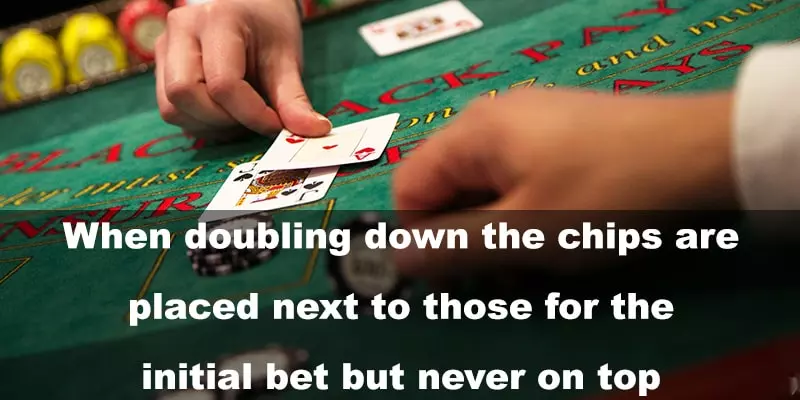
Also, it is essential to know that when you have already put your bet but are still waiting to be paid out, the chips should not be touched by any means. Another very important thing is that players should refrain from increasing their bet if they are losing as this will only contribute to losing even more money in the long term.
What Is a Dead Hand in Blackjack?
If you enjoy playing or watching poker, you have probably heard commentators speak about “dead” hands. The term is used for hands that are removed from play due to an infringement in the table rules. The hand is “dead” because it is invalid due to violation. The term “dead” hand is also used in blackjack but is something of a misnomer in this instance.
It refers to the situations when all players at the table exceed the maximum total of 21, automatically losing the round. When this happens, the dealer would simply turn over their face-down card to the benefit of surveillance, place players’ cards in the discard tray, and collect the losing wagers off the felt.
They would not take any hits even if their hand’s total is under 17. It makes no sense for the dealer to complete their total and waste extra cards since he or she has already won the round against the busted players. This is one of the main reasons why the house has an edge over blackjack players, albeit a small one. We shall cover this subject later on in this guide.
The Insurance Bet
Apart from hitting, standing, doubling, surrendering, and splitting, blackjack players have one additional playing option. They can purchase insurance against a prospective blackjack on behalf of the dealer. This becomes a viable move only on condition the dealer starts their hand with an exposed ace.
Players can buy or decline insurance at the very start of the round before the dealer has looked under their hole card for a blackjack. When accepting insurance, the player must make a new bet that amounts to half of their main wager.
This extra wager pays 2 to 1 and wins if the dealer turns out to have a blackjack after checking their hole card. The main bet loses unless the player’s hand is a blackjack as well. If the dealer does not have a blackjack, the insurance wager loses. The player is then free to make playing decisions on their hand, getting to choose from the five moves we described above.
Blackjack Strategies
Now that the basic rules and moves of the game have been clarified, let’s have a look at the possible options players have in order to achieve the desired win. Blackjack is a card game and as such, it follows a particular pattern which can be predicted to some extent. Therefore, the outcome of every hand can be influenced by using the right strategy and skills. This is the reason why throughout the years, many professional players have established a number of ways which increase their chances of gaining advantage over the casino.
Blackjack Rules
Blackjack Variations
Blackjack House Edge
Blackjack Odds and Probabilities
Blackjack Soft & Hard Hands
Basic Strategy
The most famous strategy in blackjack is the basic strategy which has been greatly perfected and improved over the years. Nowadays, players can find many variations of it which suggest different moves in a particular situation. This huge diversity of the available basic strategy charts is partly due to the fact that a number of blackjack variations have appeared in many casinos as well.
Strategy moves are influenced by playing conditions such as the number of decks, the rules for the dealer, the availability or absence of surrender, and so on. This strategy has proven to be extremely efficient as it significantly reduces the players’ monetary losses if applied correctly.
The basic strategy chart is specially designed to help them make the best possible decisions in a particular situation. Its suggested moves are based on the players’ hand total and the dealer’s up card. It is a necessary guide that blackjack enthusiasts should always keep in mind if they want to reduce their money losses to a minimum.
There is also a more advanced and therefore, more accurate approach known as composition-dependent strategy, in which case the number and the values of the cards in the player’s hand are also taken into consideration.
The basic strategy is dependent on the rules of the game and even the smallest changes can lower its effectiveness. This is the reason why players should always have a look at the casino rules beforehand in order to manage to apply it correctly.
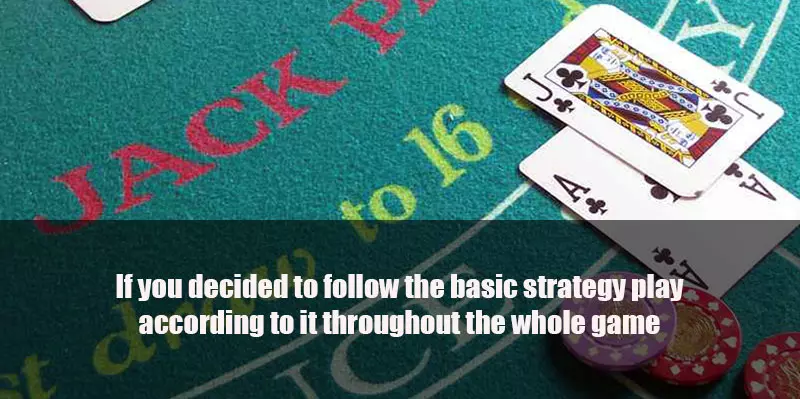
Card Counting
Card counting is another very popular strategy in Blackjack which is considered to be more advanced. Thus, it is predominantly used by more experienced players who have already mastered the basic strategy. As a matter of fact, even card counters rely on basic strategy. However, they often deviate from it when the remaining deck or shoe composition justifies it. In order to be able to derive the valuable information from the cards using this method, they also need to be able to apply the basic strategy correctly.
When both methods are incorporated, players can significantly increase their chances of winning. The reason why is that the basic strategy’s suggested moves are based on the fact that the upcoming cards in the game are unknown. However, the card counting method gives players the chance to determine the ratio of the high value cards to the low value ones and therefore, fill the missing information.
Even though the card counting method is viewed as more difficult to conduct due to the card counting process itself, it provides very accurate information of the cards on the condition that players manage to apply it correctly. Nowadays a number of card counting systems can be found, most of which use the universal principle of assigning point values to the ranks of the cards which aims at easing the calculating process. Card counting significantly increases players’ chances of winning in the long term and provides them with precious information of the cards which makes it so worth trying.
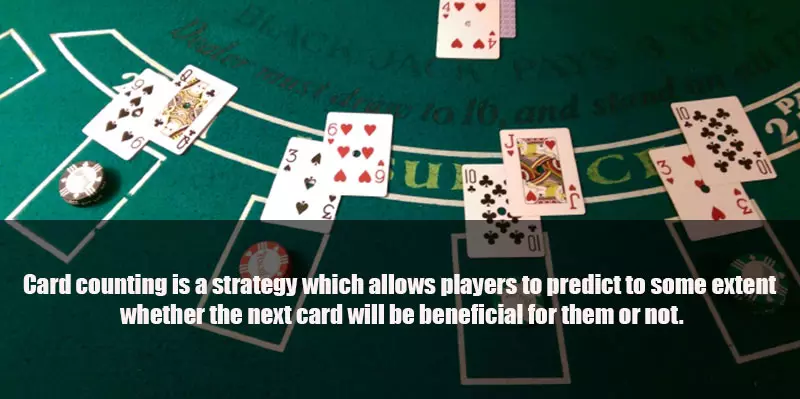
Useful Tips
There are some unwritten rules which professional players follow when they go to the casino to play blackjack. For instance, it is best to find a full table or one where there are as many fellow patrons as possible. This piece of advice is frequently given to basic strategy players and here is why. Basic strategy is essential because it causes a considerable dent in the advantage of the casino.
However, it cannot eliminate it, which is to say those who use it are still playing at a disadvantage, albeit a very small one. The more hands a basic strategy player plays per hour, the quicker the house edge will grind down their bankroll. Logically, one such player will go through fewer rounds per hour when at a full table.
This slows down the rate at which one is losing money, which is always a good thing. And conversely, when one consistently plays at empty tables or tables with one to two seated players, the house edge will catch up to them more quickly due to the higher number of hands they will play per hour at a disadvantage.
Another useful tip is before choosing a table, to have a look at the minimum stake it offers. It needs to correspond to the players’ bankroll otherwise, they risk not only losing their money but also finding themselves in an awkward situation. Speaking about money, it is highly recommended not to take any credit cards to the casino.
The reason behind this warning is obvious – gambling is a two-edged sword. As such, it can be very entertaining but also addictive. Using a credit card allows players to spend money that they might be unable to repay and it is extremely easy to use up virtual funds. Avoid many potential threats and nuisances by simply using only cash when going to the casino.